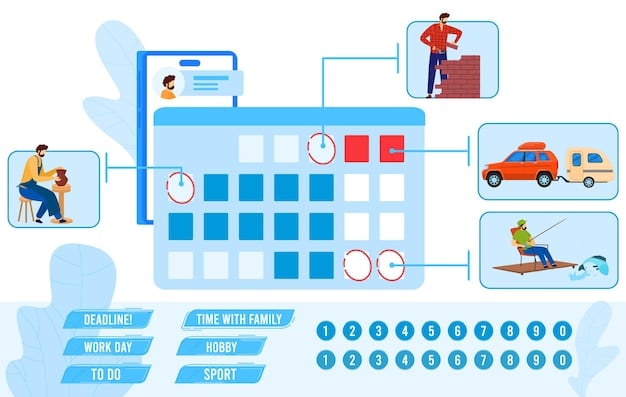MLS Transfer Window: Dates, Strategies & Top Talent Acquisition

The MLS Transfer Window: Key Dates and Strategies for Acquiring Top Talent are fundamental for Major League Soccer teams to enhance their squads, align with strategic goals, and boost competitiveness during specific periods of the year.
Navigating the MLS Transfer Window: Key Dates and Strategies for Acquiring Top Talent is crucial for teams aiming to bolster their squads and make strategic moves. This guide provides a comprehensive overview of the key dates and effective strategies for acquiring top talent in Major League Soccer.
Understanding the MLS Transfer Window
The MLS transfer window is a period when Major League Soccer teams can register new players to their rosters. These windows are vital for teams looking to strengthen their squads, whether addressing weaknesses or reinforcing existing strengths.
The structure of the MLS transfer window is unique, designed to balance competition and provide teams with strategic opportunities. Let’s delve deeper into why these windows are so important.
Why the Transfer Window Matters
The transfer window allows teams to strategically add players who can make an immediate impact. It’s a chance to address mid-season injuries, replace underperforming players, or bring in fresh talent to boost morale and performance.
- Strategic Reinforcement: Teams can target specific positions to strengthen their lineup.
- Addressing Weaknesses: Identify and rectify weak spots in the squad.
- Boosting Morale: New signings can inject energy and enthusiasm into the team.
During these periods, clubs meticulously scout, negotiate, and finalize deals to secure players that align with their tactical philosophies and long-term goals. The success of these acquisitions can significantly impact a team’s performance, making the transfer window a high-stakes period for MLS clubs.
Key Dates for the 2024 MLS Season
Knowing the exact dates of the transfer windows is essential for planning. These dates dictate when teams can officially make roster changes, so marking them on the calendar is a must.
For the 2024 season, there are two primary transfer windows. Here’s a breakdown of the crucial dates:
Primary Transfer Window
The primary transfer window typically occurs in the winter months, allowing teams to prepare for the upcoming season. This is the most active period for player movement, with numerous signings and trades taking place.
- Opening Date: Usually opens in late January or early February.
- Closing Date: Typically closes in early May.
During the primary window, teams focus on building a competitive roster for the entire season. Strategic acquisitions made during this period often set the tone for the team’s performance in the league.
Secondary Transfer Window
The secondary transfer window opens mid-season, providing teams with another opportunity to make adjustments to their squad. This window is crucial for addressing any issues that have surfaced during the first half of the season.
- Opening Date: Usually opens in early July.
- Closing Date: Typically closes in early August.
The secondary window is often used to bolster the squad for a playoff push or to replace players who have been injured or underperforming. Being strategic during this period can determine a team’s success in the latter part of the season.

Staying informed about these dates allows teams to plan and execute their transfer strategies effectively. Missing these deadlines can have significant consequences for a team’s ability to compete.
Strategies for Acquiring Top Talent
Acquiring top talent requires a well-thought-out strategy. It’s not just about identifying good players; it’s about finding the right fit for the team’s tactical system and culture.
Several strategies can be employed to secure top players. Let’s examine some of the most effective approaches:
Scouting Networks
A robust scouting network is essential for identifying emerging talent around the world. Scouts attend matches, analyze player data, and provide detailed reports on potential targets.
Effective scouting involves:
- Global Coverage: Scouts should cover various leagues and regions to identify a wide range of talent.
- Data Analysis: Utilize data analytics to identify players who excel in key performance metrics.
- Personal Observation: Combine data analysis with personal observation to assess a player’s character and fit within the team.
Clubs invest significantly in these networks to gain a competitive edge in the transfer market. Early identification of promising players can lead to securing them at a lower cost before their market value increases.
Leveraging International Connections
MLS teams often leverage international connections to scout and recruit players from abroad. Establishing relationships with agents, clubs, and academies in other countries can provide access to a wider pool of talent.
Benefits of international connections include:
- Access to Hidden Gems: Discover players who may not be widely known but possess significant potential.
- Negotiating Power: Build trust and rapport with international clubs to negotiate favorable transfer terms.
- Cultural Understanding: Recruit players who can adapt to the culture and playing style of MLS.
These connections are invaluable for teams looking to add diverse skills and experience to their rosters. International players often bring unique perspectives and qualities that can enhance a team’s overall performance.
Utilizing the MLS Draft
The MLS SuperDraft is an annual event where MLS teams select eligible college players. While the draft has evolved over the years, it remains a viable avenue for acquiring young talent.
Key considerations for the MLS Draft:
- Thorough Assessment: Evaluate college players based on their performance, potential, and fit within the team’s system.
- Strategic Drafting: Prioritize positions of need and target players who can contribute immediately.
- Development Focus: Provide young draftees with the resources and mentorship needed to develop into seasoned professionals.
The MLS Draft can be a cost-effective way to add promising young players to the roster. Teams that excel in identifying and developing these prospects can reap significant benefits in the long run.
Financial Considerations in MLS Transfers
Financial considerations play a significant role in MLS Transfer Window: Key Dates and Strategies for Acquiring Top Talent. Understanding the league’s salary cap, allocation money, and other financial mechanisms is crucial for managing player acquisitions effectively.
MLS has unique financial rules designed to promote competitive balance. Let’s explore some of the key financial aspects of player transfers:
Salary Cap
The MLS salary cap restricts the amount teams can spend on player salaries. This cap ensures that no single team can dominate the league through sheer financial power. As a result, clubs must be strategic in how they allocate their resources.
Understanding the salary cap involves:
- Base Salaries: Track the base salaries of all players to ensure compliance with the league’s regulations.
- Designated Players: Utilize Designated Players (DPs) strategically, as they are only partially counted against the salary cap.
- Roster Composition: Balance high-priced DPs with cost-effective players to create a well-rounded and compliant roster.
Managing the salary cap requires careful planning and execution. Teams must make tough decisions about which players to retain and which to let go in order to stay within the league’s financial guidelines.
Allocation Money
Allocation money is an additional source of funds that MLS teams can use to acquire players or reduce their salary cap burden. There are two types of allocation money: General Allocation Money (GAM) and Targeted Allocation Money (TAM).
Using allocation money effectively:
- General Allocation Money (GAM): Can be used to reduce a player’s salary cap hit or acquire players from within MLS.
- Targeted Allocation Money (TAM): Specifically used to sign players who earn above the maximum salary budget charge.
Allocation money provides teams with flexibility in managing their rosters and making strategic acquisitions. Understanding how to use GAM and TAM effectively is essential for maximizing a team’s competitiveness.
Transfer Fees
Transfer fees are payments made to a player’s former club when acquiring their rights. MLS teams must factor these fees into their overall budget when pursuing international players.
Negotiating transfer fees effectively involves:
- Market Analysis: Assess the market value of the player and comparable players in similar leagues.
- Negotiation Skills: Employ strong negotiation tactics to secure the player at a reasonable price.
- Financial Planning: Ensure that the transfer fee aligns with the team’s overall financial strategy and available resources.
Transfer fees can be a significant expense, so teams must carefully evaluate the potential return on investment when pursuing international signings. A successful transfer can significantly enhance a team’s performance, but an unsuccessful one can be a costly mistake.

By understanding and leveraging these financial tools, MLS teams can effectively manage their rosters and compete for top talent. Strategic financial planning is just as important as tactical scouting in the pursuit of success.
Case Studies: Successful Transfer Strategies
Examining successful transfer strategies of MLS teams can provide valuable insights. These case studies highlight the impact of strategic planning and execution.
Let’s analyze a few examples of teams that have excelled in the transfer market:
Toronto FC’s Transformation
Toronto FC’s acquisition of star players like Sebastian Giovinco, Michael Bradley, and Jozy Altidore transformed the team into a powerhouse. This strategy of bringing in established international talent paid off with an MLS Cup victory.
Key elements of Toronto FC’s strategy:
- Targeted Acquisitions: Identified players who could make an immediate impact and fit the team’s tactical system.
- Financial Commitment: Invested heavily in attracting top talent to MLS.
- Strategic Integration: Ensured that new signings were integrated into the team’s culture and playing style.
Toronto FC’s success demonstrated that a bold and well-executed transfer strategy can elevate a team from mediocrity to championship contention.
Atlanta United’s Youth Movement
Atlanta United’s focus on developing young talent and integrating them with strategic international signings has been a recipe for success. Players like Miguel Almirón and Josef Martínez were key components of their MLS Cup-winning team.
Key elements of Atlanta United’s strategy:
- Scouting Expertise: Identified promising young players from South America and other regions.
- Development Focus: Provided young players with the support and mentorship needed to thrive in MLS.
- Balanced Roster: Combined young talent with experienced veterans to create a well-rounded squad.
Atlanta United’s approach highlights the importance of a balanced roster that combines youth, experience, and strategic international signings.
These case studies underscore the importance of strategic planning, effective execution, and a deep understanding of the MLS landscape. Successful teams are those that can identify, acquire, and integrate top talent into their rosters effectively.
| Key Point | Brief Description |
|---|---|
| 📅 Key Dates | Primary and Secondary Transfer Windows are crucial for roster changes. |
| 🌐 Scouting Networks | Essential for identifying emerging talent globally. |
| 💰 Financial Rules | Salary Cap, Allocation Money, and Transfer Fees impact team strategy. |
| 🏆 Case Studies | Toronto FC and Atlanta United show varied paths to success. |
Frequently Asked Questions
▼
The primary MLS transfer window typically opens in late January or early February and closes in early May, allowing teams to prepare for the season.
▼
The secondary transfer window usually opens in early July and closes in early August, providing a mid-season opportunity for teams to adjust their rosters.
▼
Allocation money includes General Allocation Money (GAM) and Targeted Allocation Money (TAM), which teams can use to reduce salary cap or acquire players.
▼
The salary cap restricts the total amount teams can spend on player salaries, promoting competitive balance by ensuring no single team dominates.
▼
Designated Players (DPs) are players whose salaries only partially count against the salary cap, allowing teams to attract high-profile talent.
Conclusion
Understanding the intricacies of the MLS transfer window is vital for any team looking to build a competitive roster. By knowing the key dates, employing effective acquisition strategies, and navigating the league’s financial rules, teams can position themselves for success on and off the field.





